by Admin Mediterra | Sep 24, 2020 | Stroke Length
These charts below will help you estimate your optimal Strokes-Per-Length (SPL) range for various pool lengths. This is sometimes referred to as your Green Zone.
These charts are just to help you aim in the right direction. There are many factors you should consider when fine tuning which range of stroke counts are best for your body and event. Read When Choosing Your Optimal Stroke Count for more insight, and you might enjoy reading The Back Story Of The Stroke Count Charts to learn about how they were created.
Your Precise SPL Range
This chart estimates a range of about 5 SPL points. However, through testing and practice we recommend that you narrow your personal range down to 3 SPL points.
For example, for a male swimmer about 40 years old, 180 cm tall, the chart above suggests a 16-20 SPL in a 25 meter pool. If he has highly developed streamline and stroke efficiency he may aim for 16-18 SPL as his target SPL range. If less developed he may aim for 18-20 SPL.
What Is This Range For?
Changing SPL during a swim functions a bit like switching gears on your bicycle, allowing you to adjust the pressure and frequency of the stroke to use energy just the way you need to for a particular event or conditions.
Your higher SPL count is generally for shorter distance, higher tempo, or lighter pressure strokes. Your lower SPL count is generally for longer distances, lower tempo, or higher (steady) pressure strokes.
25 METER Pool
This chart is for SPL in a 25 meter pool, assuming you take a 5 meter from push-off to first stroke.
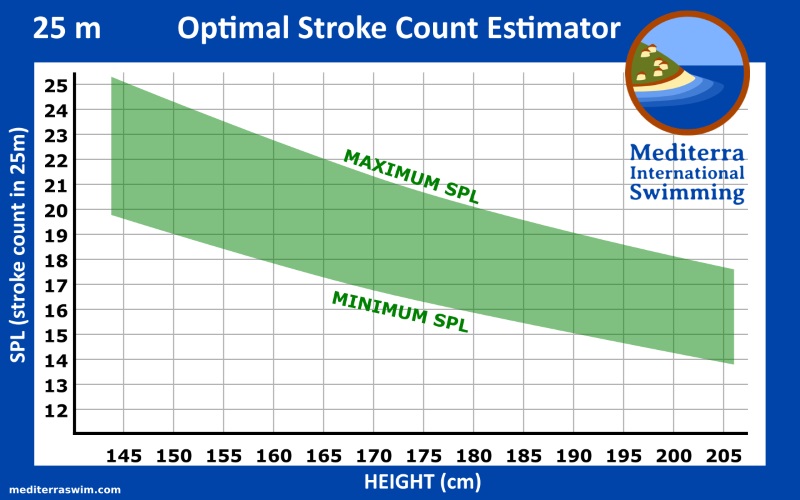
25 YARD Pool
This chart is for SPL in a 25 yard pool, assuming you take a 5 yards from push-off to first stroke.
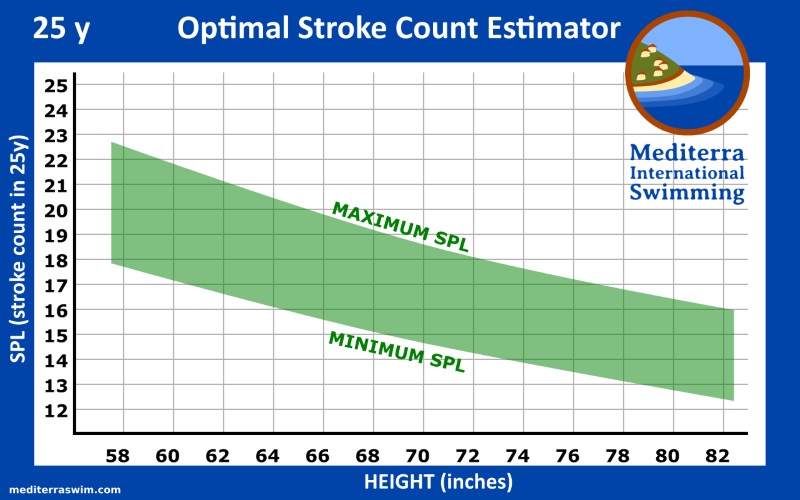
50 METER Pool
This chart is for SPL in a 50 meter pool, assuming you take a 5 meter from push-off to first stroke.

Switching Between 25 METER and 25 YARD
If you switch between 25 m and 25 yd pools a rough rule-of-thumb is to allow for a 2 stroke count difference between your SPL in the two pools. A 25 meter pool is approximately 2.3 yards longer than a 25 yard pool, and that extra distance equals about 2 strokes for people of middle height range.
Terminology
In practices listed here on the TI Academy, when we refer to SPL, we will use terms like N, N-1, N+1, etc. N = the lowest number in your optimal SPL Range.
It’s not the lowest SPL you can possibly achieve, but the lowest within the range of appropriate SPL for your continuous swimming – in that range that is good for your energy use and shoulder health.
If you have an SPL Range of 16 to 19, then your N = 16, N+1 = 17, N+2 = 18, N-1 = 15, etc.
How These Charts Were Calculated
Based on observation of swimmers and comparison of data we see a strong case for setting a swimmer’s SPL range between 55% and 70% of their wingspan. The minimum SPL on this chart corresponds to 55% of height and the maximum corresponds to 70%.
We chose to use height for these charts because most people know immediately what their height is, and for estimation purposes, that is close enough. Wingspan is the measurement of your arms spread wide, measured from finger tip to finger tip. Wingspan provides the more accurate estimate of what your stroke length potential is. In humans height is approximately the same as wingspan, within +/- 5% margin of difference.
We see this difference between height and wingspan also matters but we’ll save that discussion for another article.
Precise Personal Metrics
If you want to do the math to get more precise, personalized SPL for yourself you need this data:
- Your wingspan (W)
- Your pool length (PL)
- The distance of your glide to stroke #1 (DG)
Then we start the calculations working with Stroke Length (SL).
Calculate your minimum 55% SL: W x .55 = min SL
Calculate your maximum 70% SL: W x .70 = max SL
Then we convert from SL to SPL which is dependent on your pool length and glide.
Calculate your minimum SPL: (PL – DG) / max SL = min SPL
Calculate your maximum SPL: (PL – DG) / min SL = max SPL
Consistent Push-Off Matters
How far you glide after pushing off from the wall to your first stroke affects your stroke count. If you followed the math calculations above you’ll notice that a short push-off will require you to take an extra stroke or two to reach the far wall, while a long one will allow you to take one or two strokes less.
Work on keeping this push-off and glide distance consistent on every lap. If you have a long glide (5-6 meters) you can aim for a lower end of your SPL range. If you have a shorter glide (3-4 meters) you can aim for the higher end of your SPL range. 4-5 meter push-off to glide is a good average to aim for.
by Admin Mediterra | Sep 24, 2020 | Metrics
This chart shows Stroke Length x Tempo combinations to create Pace for 100 meters (in seconds). This chart is intended for open-water (no walls, no flip-turns or interruptions to the stroke), therefore
Pace = (100m/SL) x Tempo
For example: Maria uses a Stroke Length of 1.05 (red numbers, vertical column) and a Tempo of 1.10 seconds per stroke (blue numbers, horizontal row) to create a Pace of 104.8 seconds or 1 minute 44.8 seconds per 100 meters.
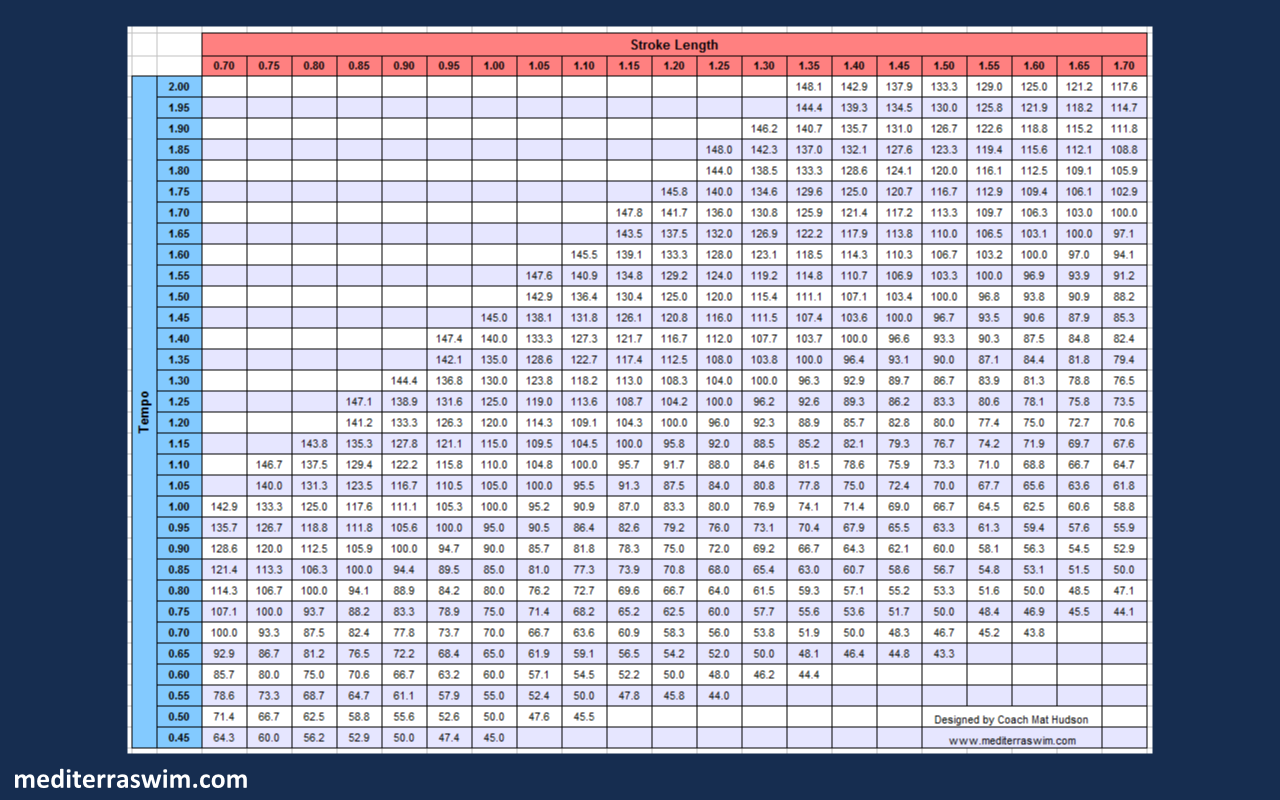
To convert your pool SPL into universal Stroke Length number:
Pool Length – Glide Distance = Swim Distance
Swim Distance / SPL = SL
For example:
Maria swims in a 25 meter pool. She glides 5 meters from the wall to begin her first stroke #0. She has an average SPL of 19.
25m – 5m = 20m Swim Distance
20m / 19 SPL = 1.05 meters per stroke.
**
Keep in mind that if you are training to achieve a certain Pace for open-water swimming, you need to train for that Pace. The speed of flip-turns and push-offs in the pool affect the Pace equation. The distance you actually swim (take strokes) in the pool is what is training you for that open-water event, not the flip-turns and push-offs. So I recommend that you pick your SL (SPL) x Tempo combination based on the setting (pool or open-water) that you are preparing to race in.
by Admin Mediterra | Sep 24, 2020 | Metrics
This chart shows SPL x Tempo = Pace combinations for a 25 meter pool. It assumes the swimmer will push-off and glide for 5 meters before beginning Stroke #1.
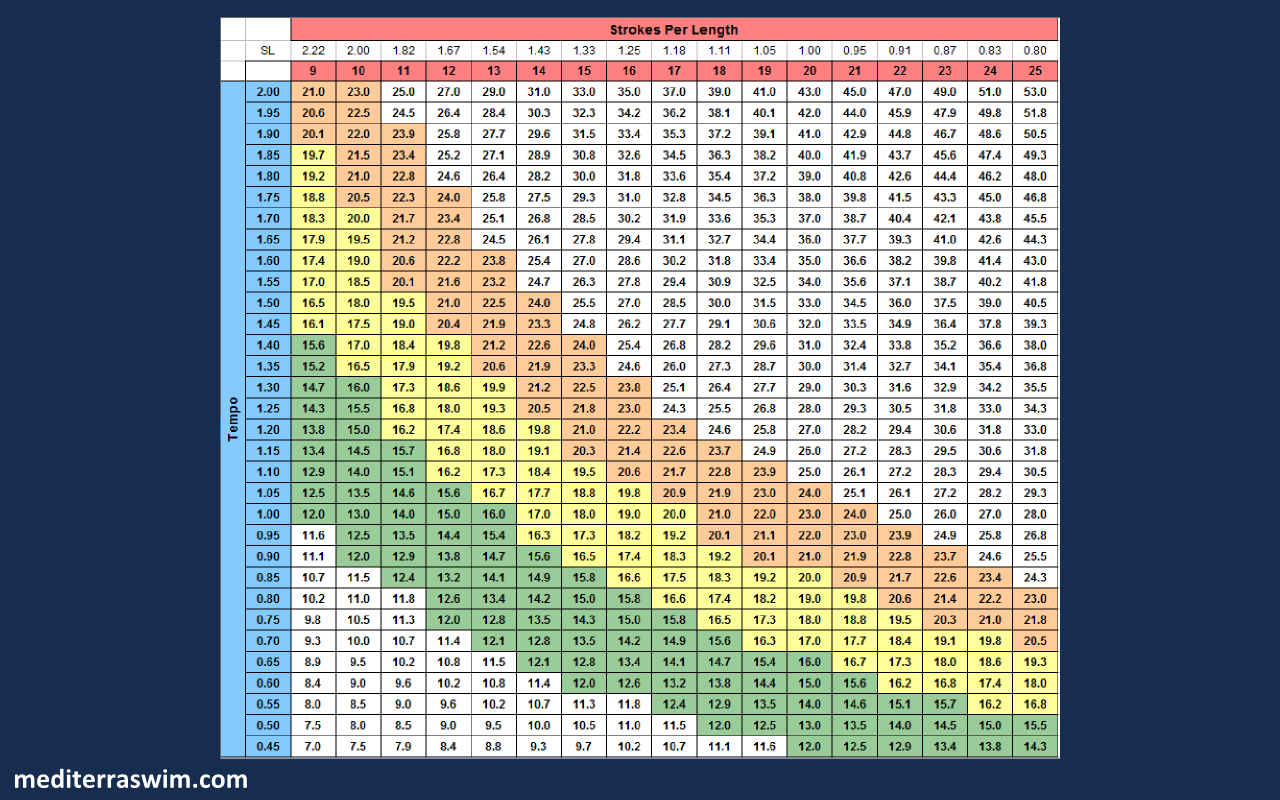
You may have in mind some fixed number for any one of the three variables (SPL, Tempo, or Time) and then you can look at you options for the other two variables connected to that by the chart.
For example, Juan wants to achieve a pace of 24 seconds per 25 meters. His SPL range is 17-19. So, looking at the rows that correspond to SPL 17-19 and 23-24 seconds, shows him that he must train with Tempo in the range of 1.10 seconds (with 19 SPL) to 1.25 seconds (with 17 SPL).
by Admin Mediterra | Sep 24, 2020 | Advanced Skills
The most common way to count strokes is to count each arm entry. When you push off from the wall, you will glide for a moment with the arms extended in streamline in front of your head. As your body approaches the surface you set the catch with one arm and that becomes the “0” stroke count. That arm exits and swings forward to entry, and as it enters, that becomes “1” stroke count, and then you count every entry after that until you touch the wall on the other side of the pool.
Another way to count is to count that first underwater catch (rather than wait for it to go all the way around to the entry), and then count every catch after that. This will result in 1-stroke higher count than the previous method.
It does not matter which way you choose to count as long as you are always counting the same way every time you do stroke counting. If you want to compare your count to someone else’s count make sure the pool length is the same and that they are counting the same way you are.
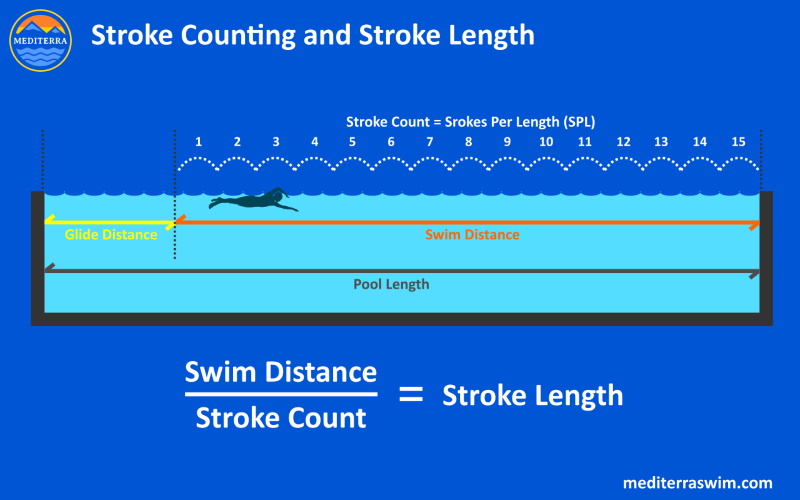
Your count will be affected by your push off from the wall. You should practice pushing off and gliding the exact same intensity and distance every time (when you intend to count strokes). If you push off and glide the same distance to your first stroke on every length of the pool, then your stroke count can be compared from length to length. But if you push off and glide less or more distance on each length then your stroke count will be affected – if you glide less distance then you have to take more strokes, if you slide more you take fewer strokes.
What Is A ‘Good’ Stroke Count For You?
There is a lot of variability in what would be an appropriate or ‘good’ stroke count for different people in different situations and purposes for swimming.
You can read more on the discussion of stroke counts in these articles:
Stroke Count Charts
When Choosing Optimal Stroke Count
Back Story on the Stroke Count Charts
Regardless of what is a ‘good’ stroke count for you, your first objective is to get in control of your stroke count and learn how to shift it up or down and develop the strength to hold consistent your current stroke count for longer durations of swimming. Then you will be in better position to know how far you should aim to improve it and what kind of work will be involved to do that.
by Admin Mediterra | Sep 24, 2020 | Advanced Skills
Stroke counting is not the only, but it is one of the first, most convenient and important ways to measure your skillfulness in the pool.
While you are taking strokes, your body slides forward some distance on each stroke. The farther you slide on each stroke the closer you come to the other side. The farther you slide on each stroke the fewer strokes it will take to get to the other side. By counting the number of strokes you are taking, you get a measurement of that distance you travel. You can travel farther on each stroke by either increasing effort or decreasing drag (water resistance). Strength is important to move forward, but shape is more important. As you improve your skillfulness in the fundamental and advanced skills your stroke will get longer as a result.
Now, one can try to pull much harder, use more effort and travel farther, but that approach has very limited potential without at least as much skill in place to support it. And, it is possible to try to slide too far on each stroke, to overdo the rotation and strain the body in an attempt to go father, but that will not be comfortable, it will not be sustainable, and it is rarely a problem we see in the first stage of developing the stroke.
Some people complain that they are concentrating too much on some aspect of their stroke to be able to count strokes at the same time. This might be the case at the beginning stage of learning a when the level of concentration on a newly introduced skill is high. However, the process of turning skillful swimming into something you can do without thinking about it will require dividing your attention. By counting, you get to occupy both sides of the brain – one side is focused on a quality in the stroke and the other side is focused on counting. Counting strokes gives you immediate feedback about what your stroke is producing, right there in that moment. If you are concentrating so much on making your body move forward better, then seeing how far you travel is a logical and convenient way to monitor how well your body is moving forward. You will only get comfortable with stroke counting by doing it more and more.






